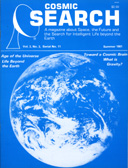![[NAAPO Logo]](../../Images/NAAPOsm.jpg) North American AstroPhysical Observatory (NAAPO)
|
|
In Review:
By: Robert H. Van Horn
COMMERCIAL OPERATIONS IN SPACE 1980-2000. Volume 51, Science and Technology, 1981, 214 pages, Hard Cover $30; Soft Cover $20. SHUTTLE/SPACE LAB — THE NEW TRANSPORTATION SYSTEM AND ITS UTILIZATION, Vol. 43. Advances in the Astronautical Sciences, 1981, 342 pages, Hard Cover $45; Soft Cover $35. Published by the American Astronautical Society. P.O. Box 28130, San Diego, CA. 92128.
These companion volumes give an overview of the present state of engineering planning for civilian utilization of space. Solar power collected in space and transmitted to power grids on earth, exotic new materials from space, scientific experiments free of atmospheric distortions, all these and more have advanced to realistic engineering planning stages. These plans are set forth in these volumes in considerable detail.
Each volume represents the Proceedings of an engineering conference and contains the texts of the engineering papers presented at these conferences. Each paper can be read independently of the others. The reader does not need a Ph.D. to read the papers with profit, but a general understanding of technical material would be most helpful.
COMMERCIAL OPERATIONS IN SPACE 1980-2000 covers the proceedings of the 18th Goddard Memorial Symposium (1980). It contains eighteen papers, all but two by authors directly or indirectly associated with NASA programs. The two exceptions are French papers dealing with future commercial operations in space. One in particular makes a comparison between the USA's Space Shuttle and the European Space Agency's ARIANNE project. The Space Shuttle uses reuseable vehicles to launch working payloads into orbit, while ARIANNE is based on the use of expendable vehicles. After looking in detail at technical and economic pros and cons, the author suggests that the two concepts may be usefully complementary.
Other papers in COMMERCIAL OPERATIONS deal with the economic outlook for private commercial operations in space, manufacturing facilities for making new materials in the ultra-clean gravity-free environment of space, space vehicle design, use of satellites to survey earth resources or to collect solar power for transmission to earth, etc. New materials that can be made only in space may have the greatest impact on us as consumers. The absence of gravity will make possible the manufacture of metallic alloys with new and unique properties, reinforced metals or polymers, crystalline materials and pharmaceuticals.
SHUTTLE/SPACELAB covers the proceedings of the Third German Association for Air and Space Travel/American Astronautical Society Symposium held in Hannover, West Germany in April 1980. It presents twenty three papers on topics similar to those covered in COMMERCIAL OPERATIONS. About half the papers are of European origin, mostly West Germany. Several of the German papers deal with plans for operating scientific laboratories. One paper worth a special note is by an American team and describes a new design for Solar Electric Propulsion System. Such a system would use solar energy collected by the vehicle to generate high speed ion beams for thrusting the vehicle into the desired orbits. The author claims that such a system, "will bring about another order of magnitude increase in mankind's capability for exploring deep space."
These volumes would be valuable additions to the libraries of everyone having a serious working interest in space exploration and utilization.
|
